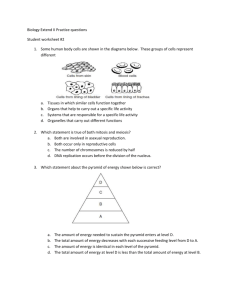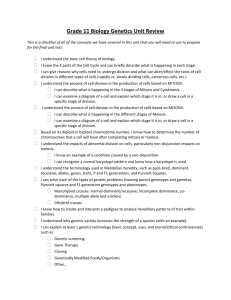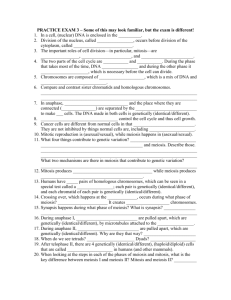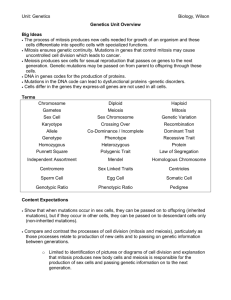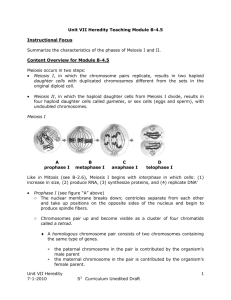AP Bio Chap 12- 15 Study Guide
advertisement
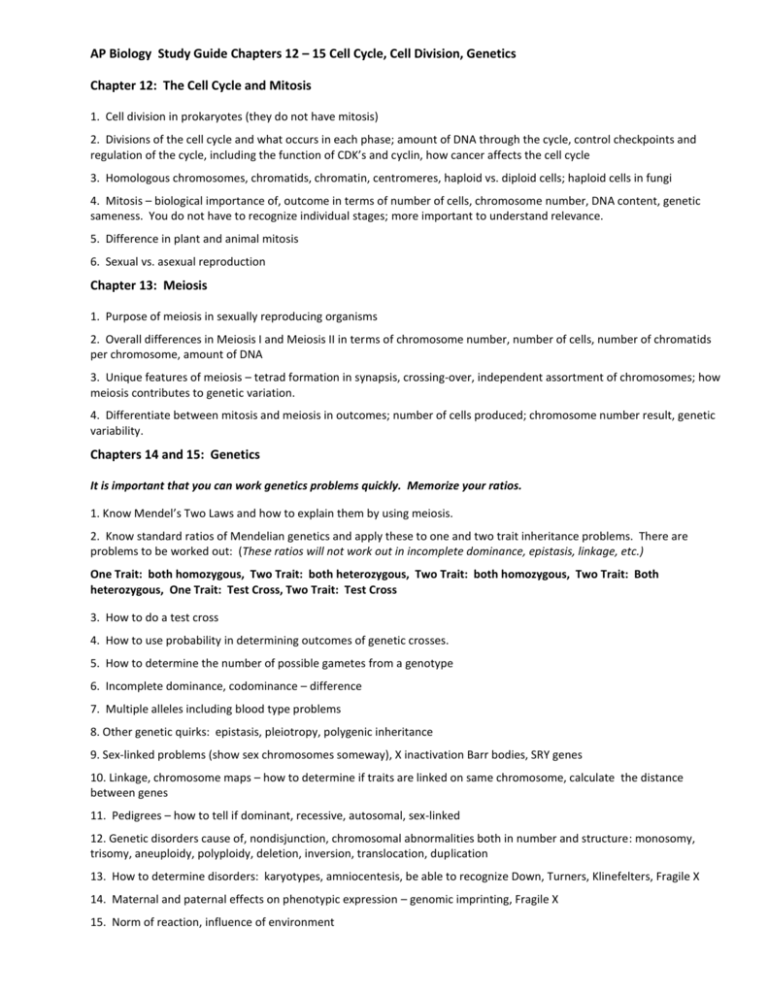
AP Biology Study Guide Chapters 12 – 15 Cell Cycle, Cell Division, Genetics Chapter 12: The Cell Cycle and Mitosis 1. Cell division in prokaryotes (they do not have mitosis) 2. Divisions of the cell cycle and what occurs in each phase; amount of DNA through the cycle, control checkpoints and regulation of the cycle, including the function of CDK’s and cyclin, how cancer affects the cell cycle 3. Homologous chromosomes, chromatids, chromatin, centromeres, haploid vs. diploid cells; haploid cells in fungi 4. Mitosis – biological importance of, outcome in terms of number of cells, chromosome number, DNA content, genetic sameness. You do not have to recognize individual stages; more important to understand relevance. 5. Difference in plant and animal mitosis 6. Sexual vs. asexual reproduction Chapter 13: Meiosis 1. Purpose of meiosis in sexually reproducing organisms 2. Overall differences in Meiosis I and Meiosis II in terms of chromosome number, number of cells, number of chromatids per chromosome, amount of DNA 3. Unique features of meiosis – tetrad formation in synapsis, crossing-over, independent assortment of chromosomes; how meiosis contributes to genetic variation. 4. Differentiate between mitosis and meiosis in outcomes; number of cells produced; chromosome number result, genetic variability. Chapters 14 and 15: Genetics It is important that you can work genetics problems quickly. Memorize your ratios. 1. Know Mendel’s Two Laws and how to explain them by using meiosis. 2. Know standard ratios of Mendelian genetics and apply these to one and two trait inheritance problems. There are problems to be worked out: (These ratios will not work out in incomplete dominance, epistasis, linkage, etc.) One Trait: both homozygous, Two Trait: both heterozygous, Two Trait: both homozygous, Two Trait: Both heterozygous, One Trait: Test Cross, Two Trait: Test Cross 3. How to do a test cross 4. How to use probability in determining outcomes of genetic crosses. 5. How to determine the number of possible gametes from a genotype 6. Incomplete dominance, codominance – difference 7. Multiple alleles including blood type problems 8. Other genetic quirks: epistasis, pleiotropy, polygenic inheritance 9. Sex-linked problems (show sex chromosomes someway), X inactivation Barr bodies, SRY genes 10. Linkage, chromosome maps – how to determine if traits are linked on same chromosome, calculate the distance between genes 11. Pedigrees – how to tell if dominant, recessive, autosomal, sex-linked 12. Genetic disorders cause of, nondisjunction, chromosomal abnormalities both in number and structure: monosomy, trisomy, aneuploidy, polyploidy, deletion, inversion, translocation, duplication 13. How to determine disorders: karyotypes, amniocentesis, be able to recognize Down, Turners, Klinefelters, Fragile X 14. Maternal and paternal effects on phenotypic expression – genomic imprinting, Fragile X 15. Norm of reaction, influence of environment
